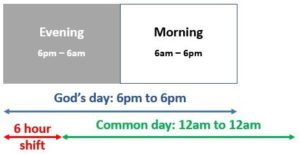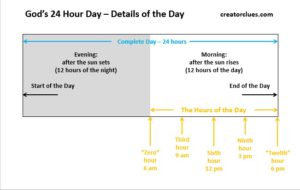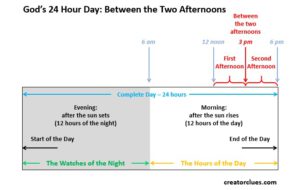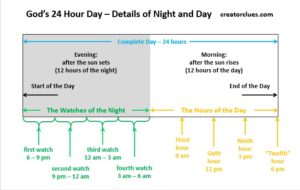
This is the second post of a series that looks at God’s 24-hour day. This post addresses how the hours of the day and night are described and understood in the Scriptures. Click here to read the first post called God’s 24-hour day according to Genesis 1:5 – God’s Time Clock to see how the common day is shifted 6 hours from God’s 24 hour day.
God’s 24 Hour Day – Details of the Night
In the Old Testament, it seems as though the night was divided into three parts. In Lamentations 2:19 we read of the beginning of the watches, then in Judges 7:19 we read of the middle watches and in Exodus 14:24 and 1 Samuel 11:11: we read of the morning watch. In Luke 2:8 it is recorded that the shepherds were keeping watch by night which helps to confirm how the night was divided into different watches. Each watch covered a period of four hours.
- The beginning of the watches corresponds to the time between 6 pm and 10 pm.
- The middle watches corresponds to the time between 10 pm and 2 am.
- The morning watch corresponds to the time between 2 am and 6 am.
The night watches described in the New Testament are based on the military watches of the then dominant Roman Empire. The night was divided into four watches. In Matthew 14:25 and Mark 6:48 we read of the fourth watch of the night. In Acts 23:23 we can read of the third hour of the night. This equals the third hour after sunset or 9 pm which corresponds to the end of the first watch and the beginning of the second watch.
- The first watch of the night corresponds to the time between 6 pm and 9 pm.
- The second watch of the night corresponds to the time between 9 pm and 12 midnight.
- The third watch of the night corresponds to the time between 12 midnight and 3 am.
- The fourth watch of the night corresponds to the time between 3 am and 6 am.

God’s 24 Hour Day – Details of the Day
In the New Testament, in Matthew 20:3; Mark 15:25; Acts 2:15 we read of the third hour, then in Matthew 27:45; Mark 15:33; Luke 23:44; John 4:6; 19:14 we read of the sixth hour, then in Matthew 27:45, 46; Mark 15:33, 34; Luke 23:44; Acts 3:1; 10:3, 9, 30 we read of the ninth hour. We can also read of the tenth hour in John 1:39 and of the eleventh hour in Matthew 20:6, 9, 12.
The hours of the day are counted from the time of the rising of the sun. As the sunrise is commonly referred to begin at 6 am, then the first hour of the day would correspond to 7 am. And subsequently hour by hour, therefore defining the times mentioned in Scripture:
- The third hour of the day corresponds to 9 am.
- The sixth hour of the day corresponds to 12 noon.
- The ninth hour of the day corresponds to 3 pm.
- The tenth hour of the day corresponds to 4 pm.
- The eleventh hour of the day corresponds to 5 pm.

God’s 24 Hour Day – An Afternoon Twist
There are two other instances of telling time that provide important details with respect to the death, burial, and resurrection of Jesus Christ.
The first such instance occurs in Mark 15:42 when mention is made of “at even”. Loosely understood, it could be rendered as “at evening time”. However, when reading the story, we can note that emphasis is being placed on getting the body of Jesus down from the cross and buried before sunset. Why the hurry? The time at which the sun set on that particular day, was the beginning of a Sabbath day; the Sabbath day began at 6 pm.
A Sabbath day is a day in which no servile work was to be done. The meaning of the word “at even” in Mark 15:42 has the sense of late in the day, or at the close of the day. This reference is commonly understood to be as the daylight portion of the day came to an end, but understanding God’s 24-hour day, we note that it is also the actual 24-hour day that was coming to an end. When the sun set, it was literally the beginning of the new 24-hour day. Please read the post on God’s 24 Hour Day According to Genesis 1:5 for a more in depth look at this important detail.
Insert graphic pending
God’s 24 Hour Day – An Evening Twist
The second instance of telling time that provide important
details with respect to the death, burial, and resurrection of Jesus
Christ is from the Old Testament and occurs in Exodus 12:6 where it mentions “in the evening”, in Leviticus 23:5 where it mentions “at even”, and in Numbers 9:3, 5, 11 where it mentions “at even”.
The words “in” and “at”, though seemingly insignificant in the reading of the text add an interesting dimension to the significance of the word “even” or “evening”. This small word indicates a distinction or a separation. As we notice in the previous post God’s 24 Hour Day According to Genesis 1:5, the evening speaks of a covering. In real terms, the covering “begins” at high noon when the sun starts to move away, figuratively “pulling” over the darkness (as someone would pull over themselves a comforter when getting ready to go to sleep).
The use of “in” and “at” gives the sense of “between the two evenings”. The distinction or separation has to do with the afternoon portion of the day or the time between noon and 6 pm. Noon corresponds to the time when the sun begins to “go down” and 6 pm corresponds to the time when the sun has “gone down”.
The afternoon is thus divided into two parts; the first part when the sun begins to go down, and the second part when the sun finishes going down. The distinction or separation is identified as the midpoint of the afternoon or 3 pm.
 Action Point: God’s 24 Hour Day – the Details of the Day and Night
Action Point: God’s 24 Hour Day – the Details of the Day and Night
- Download the printable PDF Bible Chart called God’s 24 Hour Day Details of the Night
- Download the printable PDF Bible Chart called God’s 24 Hour Day Details of the Day
- Download the printable PDF Bible Chart called God’s 24 Hour Day Details

- Download the printable PDF Bible Chart called God’s 24 Hour Day – Between the two afternoons
- To read the first part of this series click here: God’s 24 Hour Day According to Genesis 1:5
- To read the next part of this series click here: God’s 24 Hour Day the Accuracy of Time
You may be interested in these facts:
KJV translates “shabbat shabbaton” which means the cessation of the Shabbat, which would be right before sundown near evening on the sixth day of the week, where sundown starts the first day of the week. You can see italics in the translation. This has led to confusion, many thinking it refers to Sunday morning, when it is referring to Saturday night at the time of Havdalah. This is why it was dark when Miriam saw Yeshua post-resurrection.
The Jewish calendar year just turned to 5780. If we include the missing 166 years, we are at 5946, only 56 years from the end of the 6th day!
Interesting thoughts. Though I believe there is reference to the risen sun in Mark 16 when she sees Yeshua post-resurrection.
“shabbat shabbaton” maybe helps to understand when it is that He rose from the dead.
The study of calendars is an interesting topic and somewhat confusing. But yes, the end is near. Come Lord Jesus.